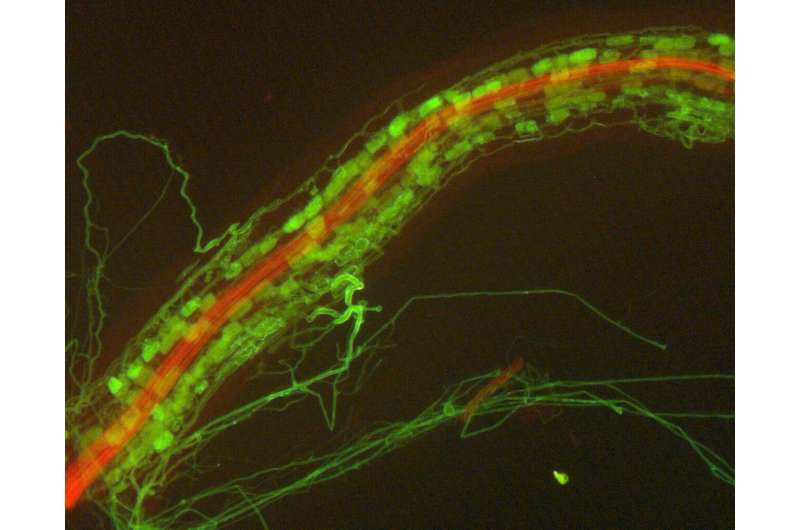This article has been reviewed according to Science X's editorial process and policies. Editors have highlighted the following attributes while ensuring the content's credibility:
fact-checked
peer-reviewed publication
trusted source
proofread
The underground network: Decoding the dynamics of plant-fungal symbiosis

The intricate dance of nature often unfolds in mysterious ways, hidden from the naked eye. At the heart of this enigmatic tango lies a vital partnership: the symbiosis between plants and a type of fungi known as arbuscular mycorrhizal (AM) fungi.
New research, published in the journal Science, delves into this partnership, revealing key insights that deepen our understanding of plant-AM fungi interactions and could lead to advances in sustainable agriculture.
AM fungi live within plant root cells, forming a unique alliance with their plant hosts. This relationship is more than a simple coexistence; it involves a complex and critical exchange of nutrients essential for fungal survival and highly beneficial for the plant.
Researchers at the Boyce Thompson Institute (BTI) have uncovered the roles of two proteins, CKL1 and CKL2, which are active only in the root cells containing the AM fungi. These two proteins belong to a larger family of proteins known as CKLs, whose functions in the plant have yet to be fully understood.
"The closest relatives of the CKL family are proteins, called CDKs, that control the plant cell cycle and are located in the nucleus of the cell. Surprisingly, the CKL1 and CKL2 proteins have evolved a different role than CDKs—they do not control the cell cycle. They are tethered to the membranes of the root cell, including a membrane that surrounds the fungus," said Dr. Sergey Ivanov, a post-doctoral researcher at BTI and first author of the study.
The scientists found that these CKL proteins are critical for the fungi's survival within plant roots. They play a pivotal role in controlling the flow of lipids (fats) from the plant to the fungi, a process essential for the fungi's nourishment. Without these proteins, key genes that manage this lipid transfer are not activated, starving the fungi.
The research also uncovered a complex web of interactions involving several receptor kinase proteins. One of these kinases is known for its role in allowing the AM fungus to penetrate the root's outer layer. The researchers discovered that this same kinase adopts a new role deeper within the root, where it partners with CKL proteins, potentially to initiate the flow of lipids to the fungus.
Surprisingly, while CKL proteins are vital for controlling lipid flow, they don't manage the entire symbiotic lipid pathway. Instead, they control genes responsible for the start and end of this pathway. Meanwhile, a key protein operating in the middle of this pathway, RAM2, is activated by a different regulator, RAM1. For full-scale lipid production to occur, both the CKL and RAM1 pathways must be active.
"Lipids are costly for the plant, so dual regulatory mechanisms may ensure that lipid provisioning is tightly controlled, perhaps a safeguard against exploitation by fungal pathogens," said Dr. Maria Harrison, a professor at BTI and senior author of the study.
Harrison continued, "In an agricultural context, leveraging this natural symbiosis could lead to crops that are more efficient in nutrient uptake and more resilient to environmental stressors."
This study not only deepens our understanding of the molecular dynamics behind plant-AM fungal symbiosis but also highlights the intricate and often unseen connections that sustain life on our planet. It's a reminder of the incredible complexity and interdependence found in nature, much of it hidden right beneath our feet.
More information: Sergey Ivanov et al, Receptor-associated kinases control the lipid provisioning program in plant-fungal symbiosis, Science (2024). DOI: 10.1126/science.ade1124. www.science.org/doi/10.1126/science.ade1124
Journal information: Science
Provided by Boyce Thompson Institute

















